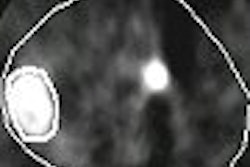Breast-specific gamma imaging (BSGI) beats mammography and MRI for the detection of ductal carcinoma in situ (DCIS), posting a higher sensitivity, according to Dr. Rachel Brem and colleagues from George Washington University in Washington, DC. The group's results come hot on the heels of an MR study that found the modality particularly adept at pinpointing DCIS in high-risk women.
"BSGI offers the advantage of being a physiologic or functional study, with sensitivity unaffected by dense breast tissue, implants, or architectural distortion after surgery or radiation," wrote Brem and co-authors in Academic Radiology. Brem is an investor in the company that manufactures the BSGI camera used in this study (August 2007, Vol. 14:8, pp. 945-950).
STUDY SUMMARY
| |||||||||
For this study, the patient population consisted of 22 women with 22 biopsy-proven pure DCIS lesions. BSGI was done before biopsy to assess indeterminate findings and after biopsy to determine occult foci and disease extent. In an e-mail interview with AuntMinnie.com, Brem said that the study did not include data on whether the women had a family history of breast cancer or a genetic predisposition. The subjects also were not categorized by breast density, she said, adding that those issues would be explored in future studies.
BSGI was performed (Dilon 6800, Dilon Technologies, Newport News, VA) after the injection of 25-30 mCi of technetium-99m sestamibi. Results were classified according to radiotracer uptake on a five-point scale with 1 representing normal with no focal or diffuse uptake, and 5 representing abnormal with marked focal tracer uptake.
Mammography was performed (DMR, GE Healthcare, Chalfont St. Giles, U.K.) in the craniocaudal and mediolateral oblique projections. Gadolinium-enhanced MR was done on a 1.5-tesla scanner, and 3D volumetric dynamic images were obtained.
According to the results, the mean pathologic tumor size was 9.9 mm in nine of 22 cases. Eleven of the lesions were given a high nuclear grade. Seventy-five percent of the patients presented with abnormal mammograms.
Of the 22 cases, mammography detected 18 for a sensitivity of 82%. In comparison, BSGI found 22 cases of DCIS for a sensitivity of 91%. In the seven of 22 women who had MR exams, the modality turned in a sensitivity of 88%. There was one false-negative MRI study, which was proved positive on BSGI.
"BSGI accurately detected all four DCIS ≥ 10 mm (100%) and all six DCIS ≤ 10 mm (100%) with measurable residual disease at surgical excision," the authors concluded. "The high sensitivity for small DCIS strengthens the utility of BSGI as an adjunct imaging modality."
In the earlier study by Dr. Christiane Kuhl and colleagues at the University of Bonn in Germany, MRI turned in a sensitivity of 92% in a study of more than 7,000 women considered to be at high risk for breast cancer. In their work, MR was able to find cases of DCIS that were mammographically occult (Lancet, August 11, 2007, Vol. 370:9586, 485-492).
Commenting on the Kuhl study, Brem told AuntMinnie.com that "it is certainly interesting that the sensitivities of BSGI and MRI are comparable (in the two studies). However, there are many advantages to BSGI including lower cost, greater ease for the patient with the issue of claustrophobia being nonexistent, the absence of gadolinium with its increasingly reported complications, and fewer images resulting in more rapid intepretation for the interpreting physican."
With regard to cost, the price tag on a BSGI unit is around $250,000, according to Douglas Kieper, director of clinical research and education for Dilon Technologies. In terms of reimbursement, a BSGI study is billed under the CMS code (CPT 78801) for tumor localization in multiple areas, he added. While the reimbursement rate for BSGI as a hospital outpatient exam ($284.13) is about half of an MRI hospital outpatiet study ($567.53), the initial investment in the BSGI unit is much lower, he pointed out.
Brem said that her group is currently undertaking a larger, multi-institutional study that will compare BSGI and MRI. One of the issues that they will look at is the specificity of BSGI. "In the meantime, all the data demonstrates that BSGI is a powerful modality for the improved diagnosis of breast cancer with significant advantages over other physiologically based modalities," she said.
By Shalmali Pal
AuntMinnie.com staff writer
August 13, 2007
Related Reading
MRI may aid diagnosis of ductal carcinoma in situ, August 10, 2007
MRI beats US for breast screening of at-risk women, but yields more biopsies, August 6, 2007
MRI spots high-grade DCIS more often than mammography: study, June 4, 2007
Breast MR shows exceptional sensitivity for spotting DCIS, January 12, 2007
Copyright © 2007 AuntMinnie.com



















